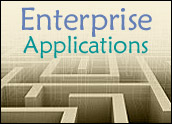
I don’t know how many old movies there are in which the good guys say, “You’re surrounded, come out with your hands up!” Somehow being surrounded is a bad thing — or at least it was — until it became a hot trend in the back office. Let me explain.
Surrounding legacy systems, such as conventional ERP, is proving to be a good idea for a bunch of reasons. Everybody remembers the last ERP implementation wave more than 15 years ago when so many businesses needed to update their software to be compliant with the new century’s dates. What we remember most are the delays, expenses, overruns — and how the projects almost cratered some companies. Back then it was everyone’s ambition not to become a headline in the business press for a new ERP implementation.
The era left some bruises and although we’re all older and wiser, the scars are deep enough to make seasoned IT people more than a little wary of a rip and replace project for the back office. Can’t blame them. But this reticence and the stasis it imposes have a cost. The now-legacy systems are becoming brittle and full of compromises caused by additional coding projects meant to keep the systems in step with their businesses.
A Practical Approach to Obsolescence
One of the most disconcerting phrases I hear these days whenever someone proposes a new business process is, “our system won’t let us do that.” So, at least in some cases, legacy systems are preventing businesses from evolving. If only there was a way to evolve while keeping the legacy systems in place, or at least without requiring a rip and replace, many businesses could get on with some challenging and remunerating work.
Today, there is a solution for this dilemma and it employs a surround strategy. Maybe you’ve heard of this. A surround strategy puts a new ring of flexible cloud-based ERP around the legacy systems, enabling the business to transfer its back office innovation to the new ring, while leaving the core system to continue with many functions, such as consolidating financial data and issuing reports. That means all, or at least most, innovation moves to the cloud — allowing processed data and workflow to proceed to the legacy system.
Surround strategies are a practical approach to ERP obsolescence and they’ve been very useful in multiple business cases. For example, many ERP systems are not adapted to subscriptions because they are not built around the concept of recurring revenue and frequent customer-inspired changes. But many cloud ERP systems and specialized subscription billing solutions integrate well together.
Cloud ERP’s saving grace is the platform which can support multiple applications and is preconfigured to work with them. FinancialForce is a case in point. Built on the Salesforce.com platform, this cloud ERP app easily integrates more than 2,000 other platform apps; so that as a business grows it can have easy access to other front- and back-office systems that help it complete its mission.
Agility Toolbox
Also, platform tools, which include social tools, journey mapping, and point and click app generation for multiple operating systems and devices, enable businesses to make improvements and modifications to platform apps without the risk of losing the improvements with the next upgrade. Thus, they can evolve with their businesses.
All of this is happening not a moment too soon, because businesses and markets are changing focus from transactions — which conventional ERP is good at — to processes. ERP and its data are key components of many business processes, but ERP has to integrate well and change frequently to keep up with business change. That’s why a surround strategy, with its improved business agility, is so important.
The surround strategy might not be right for every business, no solution is, but it opens up a wide new vista for back office workers and managers who are tired of hearing and saying, “our system won’t let us…”






















































